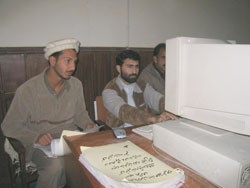
Challenge
Putting in place computer information systems to manage assistance eases relief and recovery efforts and helps relief workers assess priorities. Following the October 2005 earthquake, as villagers received care from first responders, there was a need to systematically record who received what and to identify those who needed care most. At first, word of mouth was the only tool available. But as the scale of relief efforts grew, it became clear that delivering massive supplies to the most needy required a systematic approach that reflected the scale of need.
Initiative
USAID helped establish an emergency outreach center that consolidated information about individuals needing help, village counsel determinations on loss of life and property, and the relief camps set up for those displaced by the disaster. With eight computers and several data entry assistants, the center documented individuals’ needs and losses, as well as any help they had received to date, such as compensation checks. The information helped relief workers better target vulnerable groups such as widows, children, and the aged. It also tracked the loss of homes, animals, and other property. What emerged was a better picture of needs by village, union council, and district. Relief workers and donors are now able to pinpoint which villages or people had already received assistance, and which villages still need the most help.
Results
Having met basic survival needs of people in the affected areas, relief efforts can now assess and address need gaps quickly. Now, specialists such as mental health professionals and social workers can target assistance to those who suffered the greatest loss of life. Water sanitation groups can reach out to areas that they know lack access to clean water. Any number of variables can now be obtained from one source, aiding relief, rehabilitation, and recovery of earthquake victims.







Comment
Make a general inquiry or suggest an improvement.